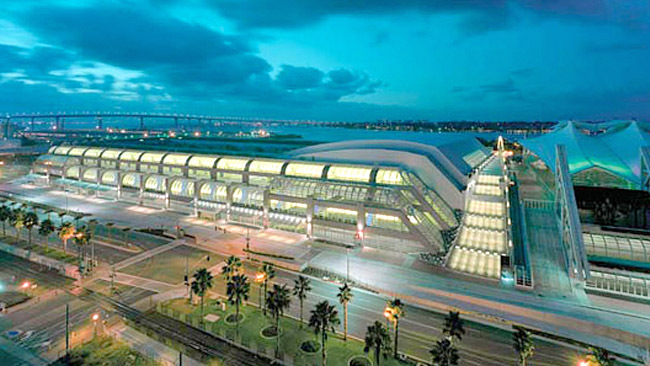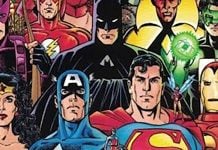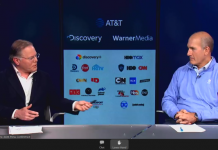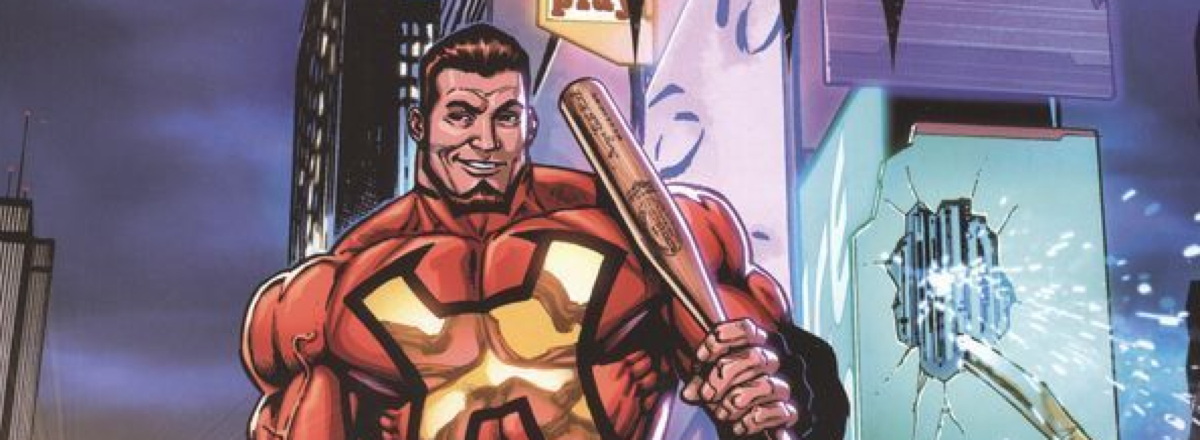By Victor Van Scoit
I planned on writing journal updates based on my daily experiences, but the time vortex that is San Diego Comic Con always wins at some point. With its voracious appetite it eats up every second of time that isn’t reserved for basic human survival – like sleep and sustenance – and even those begin to suffer. But I have time now to look back not only over the past few days, but the past ten years of attending San Diego Comic Con.
THE CONVENTION FLOOR
I was surprised that by Thursday afternoon I felt like I’d seen all ten football fields worth of pop culture goodness on the convention floor. Any additional time I spent was focused on Artist’s Alley and chasing down the final issues of Locke & Key. The former involving great conversations and artistic discoveries. The latter left me empty handed and proving that SDCC was no longer suited for back issue digging, and I would have to go to a smaller convention to experience the thrill of the hunt to fill in my collection.
The expectations of acquiring SDCC Exclusive merchandise remained in high gear. Hasbro was king with the biggest draw and people camping overnight, while Funko and Super7 had fervent demands for their toys as well. Publishers also pushed their exclusives often in combo with creator autograph sessions yet in both cases (toys and comics) the lines were in control.
In speaking with seasoned attendees there was a sense that while crowd size grew day-to-day the floor felt less packed and more maneuverable than in prior years. The Warner Brothers booth still drew large crowds for celebrity signings for the casts of Game of Thrones, The Hobbit and the like, but gone were the spectacle booths, holy grail giveaways, and additional celebrity signings that often caused traffic bottlenecks. Considering SDCC sold out of attendee tickets this year again, I was curious where all the people were especially since the number of off site ventures had decreased as well.
OFF SITE ACTIVITIES
The new mainstays were still there like Geek & Sundry Lounge, Nerd HQ, and PetCo Park’s Interactive Zone whose main draw is Adult Swim. Geek & Sundry served its niche audience well with activities like board games, video game demos, and panels featuring talent from their YouTube shows that kept attendees engaged and sticking around for their evening parties. PetCo Park’s Interactive Zone and the park near the Hilton Bayfront had brands that drew people in for a carnival like atmosphere. Nerd HQ continued to offer its Conversations for a Cause and celebrity photo opportunities but didn’t have as many offerings as last year that would keep attendees around, though they did throw a fun Thursday night dance party. Such as it was, there was a decrease in off sites that contributed to the sense that Comic Con wasn’t in crazy showbiz mode.
The decrease in Hollywood studio presence and other big branding attempts was definitely noticed. There were only a couple of hotels wrapped with ads for upcoming TV shows, and the number of parties and interactive branding spaces were small compared to years prior where there were 3-5 times as many. Consider that in 2011 when Trickster, the creator driven alterna-convention, was located in the wine bar across from the convention center. Each subsequent year they were pushed farther away from the convention center due to rising event space costs and the companies that could pay them. That same wine bar from 2011 remained unbranded and relatively empty all convention long. Rumors of greed had event space owners asking for five times more in 2014 for the same space in 2013. Mix in Hollywood being more cautious after not gaining returns on SDCC darlings like Scott Pilgrim and Cowboys and Aliens, one can speculate as to the diminishing presence.
LINES and PROGRAMMING
That’s not to say studios weren’t represented well in the lines for panels in Hall H, Ballroom 20, and the Indigo Ballroom. Attendees were quick to pull out the sleeping bags, pillows, and lawn chairs for their overnight stays so that they could gain a seat. Even the wristband mechanism that was implemented for Hall H this year seemed to help the organization. But once again it was curious to see how things had changed from what may very well be the peak of last year.
While all weekend long each of the big rooms had long overnight lines, once the rooms opened up the dynamic changed across each. Ballroom 20 would fill in for its first panel of the day and then the line hardly ever extended outside again. You could actually show up for the panel you wanted as much as an hour in advance and sometimes as little as five minutes and get your seat. Indigo Ballroom’s line remained strong compared to prior years but it benefited from better programming, yet suffered since it had less seats to offer than Ballroom 20. Such was the case Friday when I arrived at 4PM to check out both the Bob’s Burgers and Archer panels. The folks at the front of the line had been in line for four hours and were finally going to get in. These were two shows that would’ve been better suited in Ballroom 20 rather than, say, the world premiere of unknown pilot Scorpion. Perhaps we’re at a sea change where there’s not as many cultural phenomenon shows out there as there once was.
Hall H also showed how programming would affect it. I almost felt guilty being able to walk into a panel on Thursday in Hall H without having camped the night before. The only reason Hall H filled up on Thursday at one point was because Twitter notified everyone of Matthew McConaughey and Christopher Nolan’s presence. The Interstellar trailer wouldn’t be far behind and that sent everyone running. Hall H then came back in full force on Friday and Saturday with stronger programming and concluding with its usual Marvel Studios high come Saturday night. Marvel Studios still remains the Hall H crown jewel for popular culture fan as they displayed once again what other panels lacked – showmanship and hype. Just before the Marvel panel started at 5:30PM I spoke with those around me and they had only just gotten inside having been in line since 11PM the night before. That’s the harsh mistress I know the Hall H line to be.
WHAT A DIFFERENCE TEN YEARS MAKES
My first San Diego Comic Con I thought to myself, “They were right. This is big. This is way big.” The Hollywood dollars changed the game and many proclaimed SDCC was too big, overexposed, and couldn’t possibly get bigger. I thought I missed the boat to visit back when the convention was small. Each year it seemed as if something new was added like brand experiences in parking lots, video game companies participating, every hotel being wrapped in giant movie and TV posters. Hell, the Hilton Bayfront hadn’t even been built. Now I can’t even imagine San Diego Comic Con without the Indigo Ballroom or the Hilton’s Odysea Bar where I’ve met many creators and talented directors and actors. Little did I know that years later I would look back and think “My first year was tiny compared to all this.”
That first year I was helping to make HD quality video blogs for DivX’s content network. The company needed someone who understood the comic book landscape to host video segments. Back then there were no iPhones, small HD cameras, and Facebook and YouTube were nascent companies. So with high quality cameras the team would hit the floor each day looking for interviews and cool items I could point out to show exactly why comic books, pop culture, and this convention was great. It’s funny to think that there were probably only twenty similar camera crews on the floor back then. Whereas now it feels like the floor is swarming with camera crews and their portable devices, trying to record interviews and bits for their YouTube channel. You also better have industry contacts because those press and professional badges don’t go as far they used to.
Ten years also gave me the perspective to notice what I’ve alluded to earlier, which is that San Diego Comic Con just didn’t seem that crazy. I used to to enjoy walking from my hotel near Broadway down to the convention center so I could see all the brand take overs. And yet this year there wasn’t much of any pop culture interest until one would hit the area near the Hard Rock Hotel. My panel schedule of the day is typically filled with plan A, B, C, and D knowing I might not get into my first choice due to crowds. And yet this year the only reason I had to go to my second choice was due to mood and not capacity being reached in a room. While attendance for Comic Con 2014 didn’t go down the looming presence of the entertainment industry certainly did. Frankly this was the first San Diego Comic Con where I felt paced, I had time to meet with various friends, and got to do 95% of what I wanted to do. Did the entertainment money bubble burst and are we in for a few years of a normalized landscape? Is the Comic Con audience now so broad that studios and brands aren’t getting the discerning looks and cultural penetration they once were? I’ll be curious to see, and if I’m lucky I’ll get another ten years to find out.













FYI: It’s San Diego Comic-Con, with a hyphen.
I commented during the show that it felt like 2007. Floor traffic was crazy, but manageable. Hollywood was there, but not overwhelming. Sales at booths you couldn’t really pinpoint what was “hot” as some artists were calling it their best show ever while others were declaring this was their last time coming out. The only real difference was (IIRC) ’07 was one of if not THE last years people were able to walk up and buy tickets for most days. While CCI is selling out within minutes of going live with badge sales, things like NerdHQ and other offsite events have really relieved the crush inside the halls. We may be seeing another evolution of the con in progress, but it is hard to tell what sort of beast it will become.
Regarding what rooms panels belong in, you need to remember sometimes people request the smaller room. Because what looks better: a packed room with a line of people dying to get in that can’t, or a room that is only 3/4 full?
Regarding Jackie Estrada’s comment above about the hyphen in Comic-Con, this may be of interest: Con-fusion: “What’s in a Name — or a Hyphen?” http://beacon.wharton.upenn.edu/kendallwhitehouse/comic-con-confusion-whats-in-a-name/
Comments are closed.